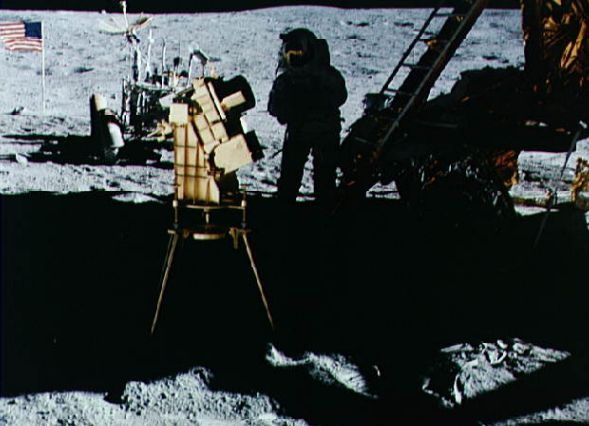Explanation: The first, and so far only, lunar astronomical observatory was deployed by the Apollo 16 crew in 1972. The Far Ultraviolet Camera / Spectrograph used a 3-inch diameter Schmidt telescope to photograph the Earth, nebulae, star clusters, and the Large Magellanic Cloud. The tripod mounted astronomical equipment is seen above, placed in the shadow of the Lunar Module (right) so it would not overheat. Also in the shadow is astronaut John Young with the lunar rover in the background. The Far Ultraviolet Camera took pictures in ultraviolet light which would normally be blocked by the Earth's atmosphere. It was created by George Carruthers (NRL), had a field of view of twenty degrees, and could detect stars having visual magnitude brighter than eleven. One hundred seventy-eight images were recorded in a film cartridge which the astronauts returned to Earth. The observatory still stands on the Moon today.
1999 2000 2001 2002 2003 2004 2005 2006 2007 2008 2009 2010 2011 2012 2013 2014 2015 2016 2017 2018 2019 2020 2021 2022 2023 2024 2025 |
Yanvar' Fevral' Mart Aprel' Mai Iyun' Iyul' Avgust Sentyabr' Oktyabr' Noyabr' Dekabr' |
NASA Web Site Statements, Warnings, and Disclaimers
NASA Official: Jay Norris. Specific rights apply.
A service of: LHEA at NASA / GSFC
& Michigan Tech. U.
|
Publikacii s klyuchevymi slovami:
Ul'trafioletovoe izluchenie - Moon - apollo program - Observatory - UV - Luna - Apollon - teleskop - ultraviolet - telescope
Publikacii so slovami: Ul'trafioletovoe izluchenie - Moon - apollo program - Observatory - UV - Luna - Apollon - teleskop - ultraviolet - telescope | |
Sm. takzhe:
Vse publikacii na tu zhe temu >> | |
